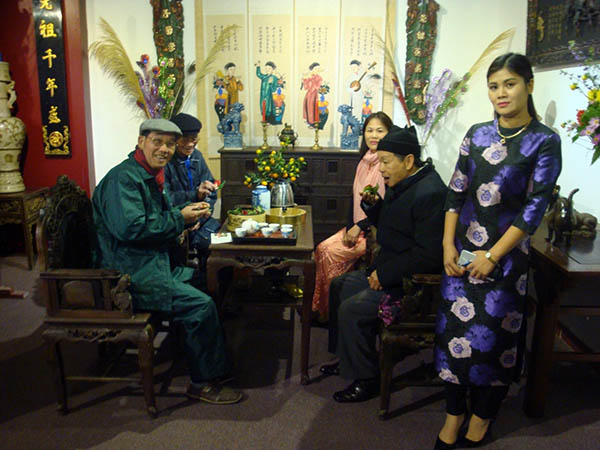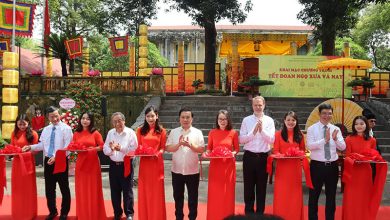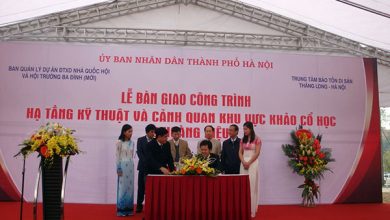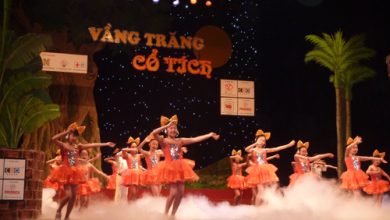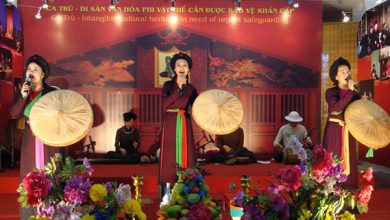Inauguration of the Thăng Long Imperial Citadel Spring Festival In celebration of the Party and the New Year 2016
The Thăng Long Imperial Citadel Spring Festival commenced on the morning of 29 January 2016 at the Kính Thiên Palace Dragon Court.
On the occasion of the Lunar New Year, the Year of the Monkey, 2016 and in celebration of the successful conclusion of the 12th National Communist Party Congress, the Thăng Long – Hà Nội Heritage Conservation Centre has worked with relevant agencies to organize various exhibitions and traditional cultural activities at the Thăng Long Imperial Citadel heritage site, providing the people with an opportunity to enjoy themselves and usher in the new year.
The Lunar New Year is the most important holiday in the cultural life of the Vietnamese people, as this is a time that marks the transition from the old year to a new year when people pay tribute to their ancestors. Featuring many different customs like picking the new bud or young leaves (hái lộc), making first visits (xông nhà), writing the first letters (khai bút), exchanging New Year wishes (chúc Tết), visiting pagodas (lễ chùa) among others, Tết is a culmination of all the most essential elements of the material and spiritual life of the Vietnamese people. The exhibition “Tết Việt” is a special activity held at Thăng Long Imperial Citadel on the occasion of the New Year 2016. Apart from the customary display and introduction of unique photos, documents, and objects about the traditional Tết, the reconstruction of the traditional cultural spaces of the Vietnamese people, such as the Tết stall, the Tết paintings, Tết costumes, Tết worshipping spaces, flower and bonsai, New Year calligraphy, this year the Organizing Committee also offers some additional interesting performances to introduce more Vietnamese traditions and customs during the Tết holiday, such as culinary art. Besides, Tết shopping, eating and playing are original cultural practices of the Vietnamese people that are handed down to today’s generation. At the exhibition, there will be many activities, for example, Đông Hồ Artist Nguyễn Hữu Quả talking about the process of making Đông Hồ paintings, artisans of Tranh Khúc village instructing on how to make a chưng cake, Artist Ánh Tuyết introducing the traditional votive food tray and demonstrating the making of the popular nem or spring rolls, etc. The participation of more than 150 students from the Experimentation High School is expected to help diffuse tradition education among young generations.
The flower and bonsai exhibition is to be held on a large area in front of the Đoan Môn (Main Gate), putting on display more than 700 bonsai items of diverse types and positions, such as the Five Blessings (“Ngũ phúc”), Flying Phoenix (“phượng bay”), Brotherhood (“huynh đệ”), Descending Dragon (“rồng sa”), Pairing (“sóng đôi”), Dragon Festival (“long hội”), Phoenix Dance (“phượng vũ”). Especially noteworthy is the exhibition of various species of flowers and orchards of the Tết holiday, such as peaches, kumquat, ochna, delicious oranges and grapefruits from various orchard farms of famous provinces. The exhibition brings together many famous artists from for example the Thăng Long Bonsai Club and sisterly provinces like Hải Dương, Hưng Yên, Bắc Giang, Nam Định, Lạng Sơn…
The flower and bonsai exhibition held on the very first days of the Lunar New Year is expected to create a colorful yet fresh and pristine space to welcome the people of Hanoi and the whole country as well as international visitors on sightseeing tours. These art products are evident of the labour and talent of the artists and art lovers, helping visitors from within and beyond the country to understand more about the Vietnamese people’s fondness for flowers especially during the Tết holiday.
It is also on this occasion that the Thăng Long – Hà Nội Heritage Conservation Centre organizes an in-situ exhibition of the recent archaeological discoveries with many cultural strata and typical vestiges such as the massive water channel of the Lý dynasty, the lemon flower tiles of the Trần dynasty, unearthing valuable relics from under the ground of Thăng Long Imperial Citadel. At the same time, the incense offering practice at the Kính Thiên Palace will also be restored, giving visitors some initial idea about the research results made recently and making some further steps towards the reconstruction of the space within the Kính Thiên Palace in the future.
During the first spring days of the new year, visitors to Thăng Long Imperial Citadel will have a chance to enjoy different cultural activities such as the ceremony of offering incense to the ancestral kings and officials, folk music performances, water puppet performance with a view to creating a festive and cheerful atmosphere imbued with national identities in the new spring.
The whole site will be decorated with colorful banners, flowers, and lanterns to welcome in the New Year 2016.
The exhibitions last from 29 January to 29 February. The demonstration of the making of chưng cakes takes place on 31 January. Folk music performances start at 9:30 on the 11, 12, 13, 14 and 16 of February while water puppet performances come in three sessions a day on the 11, 13, 15 and 16 of February.
Kim Yến
Thăng Long – Hà Nội Heritage Conservation Centre


